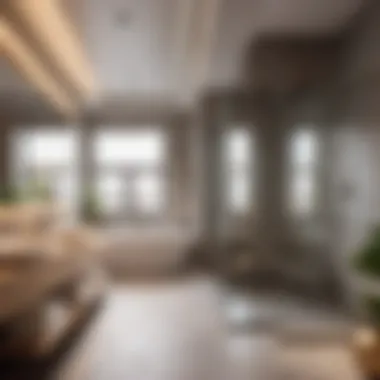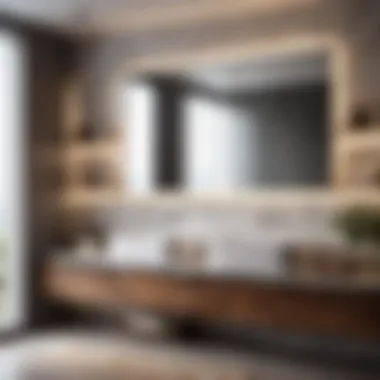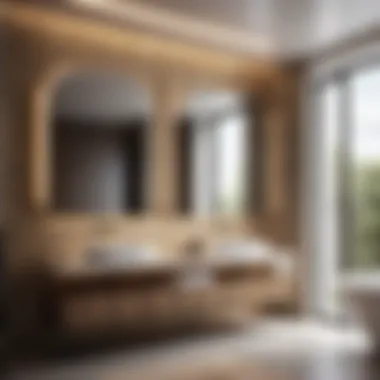Materials:
- Bathroom tiles (ceramic) - 200 sq ft
- Bathtub - Standard size
- Shower fixtures - Rainfall showerhead, handle mixer
- Bathroom vanity - Double sink, marble countertop
- Toilet - Water-efficient model
- Lighting fixtures - Vanity lights, ceiling light
- Flooring - Porcelain tiles
- Paint - Waterproof, mold-resistant
- Caulk - High-quality, mold-resistant
DIY Steps:
- Planning: Measure the bathroom space, create a layout plan, and set a budget.
- Demolition: Remove existing fixtures, tiles, and flooring carefully to avoid damage.
- Plumbing: Install or adjust plumbing connections for new fixtures.
- Installation: Lay tiles, set bathtub, mount vanity and toilet, install lighting.
- Finishing touches: Paint walls, apply caulk, check for leaks, and test all fixtures.
Technical Aspects:
- Tools: Tile cutter, wrench, screwdriver, level, drill
- Timing: Plan for 2-3 weeks for complete installation
- Techniques: Ensure proper waterproofing, level flooring, and secure fixtures
DIY Project Process:


- Start with planning and budgeting to avoid overspending.
- Carefully demolish old fixtures to prevent structural damage.
- Follow plumbing codes and hire professionals if needed for complex installations.
- Double-check measurements and placements during fixture installation.
- Address any issues promptly and test all connections before finalizing.
Troubleshooting Tips:


- Leaking pipes: Check connections and apply sealant.
- Uneven tiles: Use a leveling system for proper alignment.
- Fixture malfunctions: Test each component individually for defects.
Labor Costs


When considering the installation of a new bathroom, one of the primary aspects to account for is labor costs. Labor costs encompass the expenses associated with hiring professionals to demolish, install, and finish various elements of the new bathroom. Understanding labor costs is crucial for budgeting and planning effectively, as it can significantly impact the overall project expenditures. By breaking down labor costs into categories such as demolition, installation, and finishing, homeowners can better grasp the distribution of expenses and make informed decisions.
Demolition
Removing existing fixtures
Removing existing fixtures during a bathroom renovation is a critical aspect that influences the overall transformation of the space. This process involves dismantling items like old toilets, sinks, and bathtubs to make room for the new installations. While removing existing fixtures may seem simple, it requires skill and precision to avoid damaging surrounding areas and plumbing. The benefits of this step include clearing out outdated components, creating a clean slate for the new design, and potentially addressing any underlying issues that may be lurking behind the old fixtures.
Tearing down walls
Tearing down walls as part of a bathroom renovation can open up the space, enhance natural light flow, and allow for a more spacious layout. This process involves careful planning to ensure structural integrity while making significant changes to the original design. The advantages of tearing down walls include creating a more modern and open concept bathroom, increasing functionality, and enabling the incorporation of personalized design features. However, it is essential to consider the potential drawbacks such as structural complications, increased labor costs, and the need for additional permits.
Disposing of debris
Properly disposing of debris generated during the renovation process is essential for maintaining a clean and safe working environment. This step involves the responsible removal of materials like broken tiles, drywall, and old fixtures. Effective debris disposal can streamline the renovation process, prevent clutter accumulation, and ensure the work area remains organized. While disposing of debris is a necessary task, it can add to the project costs and require coordination with waste management services to comply with local regulations.
Material Costs
In the realm of bathroom installation, material costs play a pivotal role in shaping the overall outcome and functionality of the space. When considering the aspect of material costs, it is essential to understand that the quality and type of materials utilized directly impact the longevity and aesthetic appeal of the bathroom. Opting for superior quality fixtures, flooring, and cabinetry not only enhances the visual appeal but also ensures durability and resistance to wear and tear over time. Moreover, investing in high-quality materials can significantly elevate the value of your property, making it a wise long-term investment. Therefore, meticulous consideration and research into material costs are paramount in achieving a bathroom that stands the test of time.
Fixtures
Toilet
When it comes to selecting a toilet for your new bathroom, functionality, water efficiency, and design are key factors to consider. Choose a toilet that complements the overall aesthetic of the bathroom while also being water-efficient to minimize utility bills. Opt for features such as dual-flush options or low-flow technology to conserve water without compromising performance. Additionally, the durability and ease of cleaning should be prioritized when selecting a toilet, ensuring longevity and convenience in maintenance.
Sink
The sink is a central element in any bathroom, offering both functionality and style. When choosing a sink, consider the size of the space, the number of users, and the overall design theme of the bathroom. A pedestal sink works well in small bathrooms, creating a sense of space, while a vanity sink provides storage options and a sleek appearance. Stainless steel sinks are popular for their durability and easy maintenance, while ceramic sinks offer a timeless and elegant look. Selecting a sink that aligns with your usage needs and design preferences is crucial in completing the aesthetic and functionality of the bathroom.
Bathtub or Shower
Deciding between a bathtub and a shower depends on personal preference, space availability, and usage habits. A bathtub is ideal for relaxation and families with children, offering a spa-like experience at home. On the other hand, a shower provides convenience and space-saving benefits for daily routines. Consider factors such as material quality, water-saving features, and accessibility when choosing between a bathtub or shower for your new bathroom. Additionally, incorporating safety features like non-slip flooring and grab bars enhances the comfort and security of your bathing experience.
Flooring
Tiles
Tiles are a versatile and durable flooring option for bathrooms, offering numerous design possibilities and resistance to moisture and stains. Porcelain tiles are known for their strength and low maintenance, making them an excellent choice for high-traffic areas. Ceramic tiles come in a variety of colors and patterns, allowing customization to suit your preferred style. Additionally, mosaic tiles add a touch of elegance and visual interest to the bathroom floor. Selecting tiles that are slip-resistant and easy to clean ensures both aesthetic appeal and practicality in your bathroom space.
Vinyl
Vinyl flooring is a cost-effective and resilient option for bathroom floors, combining durability with a wide range of designs. Vinyl flooring is water-resistant, making it ideal for bathrooms prone to moisture and humidity. Luxury vinyl planks replicate the look of hardwood or stone flooring without the upkeep, providing a sophisticated appearance at a fraction of the cost. Additionally, vinyl flooring is soft underfoot and offers sound insulation properties, enhancing comfort and acoustics in the bathroom.
Laminate
Laminate flooring offers the look of hardwood or tile floors at a more budget-friendly price point, making it a popular choice for bathroom renovations. Laminate is easy to install and maintain, featuring a protective layer that resists scratches and stains. With a variety of finishes and textures available, laminate flooring allows for customization to match your desired aesthetic. Consider laminate flooring for its affordability, durability, and versatility in bringing a stylish and practical flooring solution to your new bathroom.
Cabinetry
Vanity
The vanity serves as a focal point in the bathroom, providing storage, countertop space, and a statement piece of furniture. When selecting a vanity, consider the size of the space, the number of users, and the organizational needs for toiletries and essentials. Choose a vanity with ample storage, durable countertop materials, and a design that complements the overall theme of the bathroom. Single-sink vanities work well in smaller bathrooms, while double-sink vanities cater to shared bathrooms for added convenience. Customize your vanity with features like soft-close drawers, integrated lighting, and adjustable shelves to enhance functionality and style.
Medicine Cabinet
A medicine cabinet adds practical storage and mirrors to the bathroom space, combining functionality with aesthetics. When choosing a medicine cabinet, consider the size of the mirror, the number of shelves, and the material quality for longevity. Opt for a recessed medicine cabinet to save space and create a streamlined look, or choose a surface-mount cabinet for easy installation and accessibility. Additional features like adjustable shelves, mirrored interiors, and integrated lighting offer enhanced convenience and functionality in your bathroom setup.
Storage Shelves
Storage shelves play a crucial role in organizing toiletries, towels, and decorative items in the bathroom, maximizing space and accessibility. Floating shelves add a modern touch while showcasing decor and essentials, perfect for smaller bathrooms with limited floor space. Built-in shelving creates a seamless and customized look, offering storage solutions tailored to your needs and preferences. Consider the material, weight capacity, and style of storage shelves to complement the design scheme and optimize storage in your new bathroom.
Permit and Inspection Fees
When it comes to installing a new bathroom, permit and inspection fees play a crucial role in ensuring that the project meets the necessary regulations and standards. Obtaining permits is a fundamental step in the process, as it involves obtaining official approval from the local authorities to carry out the construction work. This ensures that the project complies with municipal regulations and building codes, guaranteeing the safety and quality of the bathroom installation.
Obtaining Permits
Municipal regulations
Municipal regulations are specific rules and guidelines set by the local government that dictate how construction projects, including bathroom installations, should be carried out. These regulations cover aspects such as zoning, structural integrity, and safety requirements. Adhering to municipal regulations is crucial in ensuring that the new bathroom meets the legal standards and is safe for use. While navigating through municipal regulations can be complex, it ensures that the project is executed in compliance with the law.
Building codes
Building codes are a crucial aspect of obtaining permits for a new bathroom installation. These codes specify the minimum standards for construction practices, including plumbing, electrical work, and structural integrity. By following building codes, contractors can ensure that the new bathroom meets certain safety and quality standards. While adhering to building codes may add complexities to the project, it ultimately enhances the structural integrity and safety of the new bathroom.
Inspections
Plumbing inspection
Plumbing inspection is vital during the bathroom installation process as it ensures that the plumbing system meets the required standards. Plumbing inspections verify that the pipes, fixtures, and fittings are installed correctly and function properly. By undergoing a plumbing inspection, homeowners can identify and rectify any plumbing issues before completing the project, thereby preventing potential water leaks or other plumbing-related problems in the future.
Electrical inspection
Electrical inspection is a critical step to guarantee the safety and functionality of the electrical components in the new bathroom. Electrical inspections involve assessing the wiring, lighting, outlets, and other electrical equipment to ensure compliance with electrical codes and regulatory standards. By conducting thorough electrical inspections, homeowners can mitigate the risk of electrical hazards and ensure the proper functioning of the electrical system in the new bathroom.
Code compliance
Code compliance is essential to ensure that the new bathroom installation meets the legal requirements and industry standards. Adhering to code compliance involves following specific guidelines related to structural integrity, safety features, and construction practices. By prioritizing code compliance, homeowners can rest assured that their new bathroom is built to withstand daily use and adhere to the established norms and regulations. Although meeting code compliance may involve additional costs and effort, it guarantees a well-executed and compliant bathroom installation.
Unexpected Expenses
Unexpected expenses are a critical component to consider when embarking on a new bathroom installation project. These unforeseen costs can impact the overall budget and timeline significantly, making it vital to account for potential setbacks. By understanding and preparing for unexpected expenses, homeowners can mitigate financial stress and ensure a smoother renovation journey.
Structural Issues
Mold Remediation
Mold remediation plays a crucial role in addressing potential health hazards and structural integrity concerns within a bathroom renovation project. The presence of mold can lead to respiratory issues and compromise the durability of the bathroom space. Implementing specialized mold remediation techniques is essential to eradicate mold growth effectively and prevent recurrent issues. While mold remediation may add to the project's expenses, it is a necessary investment in creating a safe and habitable bathroom environment.
Water Damage Repair
Water damage repair is a fundamental aspect of resolving any leaks or water-related issues that may compromise the structural stability of the bathroom. Addressing water damage promptly is essential to prevent further deterioration of building materials and potential mold growth. Investing in high-quality water damage repair services ensures the longevity of the renovated bathroom and safeguards against future setbacks.
Termite Infestation
Dealing with termite infestation requires prompt action to protect the structural integrity of the bathroom and prevent extensive damage. Termites can weaken wooden structures and compromise the overall stability of the building. Engaging professional pest control services to address termite infestation is imperative for ensuring the longevity of the renovation project and maintaining a structurally sound bathroom space.
Design Changes
Upgraded Fixtures
Upgrading fixtures such as faucets, showerheads, and lighting fixtures can enhance both the aesthetic appeal and functionality of the bathroom. Opting for high-quality fixtures not only elevates the overall design but also improves water efficiency and durability. While upgraded fixtures may entail higher costs initially, their long-term benefits in terms of performance and aesthetics make them a valuable investment for any bathroom renovation.
Customized Elements
Incorporating customized elements, such as bespoke cabinetry or personalized accents, adds a unique touch to the bathroom design. Customized elements allow homeowners to tailor the space to their preferences and optimize functionality according to their specific needs. Although customization may require additional time and investment, the personalized space created enhances the overall satisfaction and usability of the renovated bathroom.
Layout Modifications
Implementing layout modifications can optimize the spatial organization and flow of the bathroom, making it more practical and visually appealing. Rearranging fixtures, changing the configuration of storage areas, or creating designated zones for different activities can enhance the functionality and efficiency of the space. While layout modifications may involve structural adjustments and additional costs, the improved usability and aesthetics they provide contribute significantly to the overall success of the bathroom renovation project.





